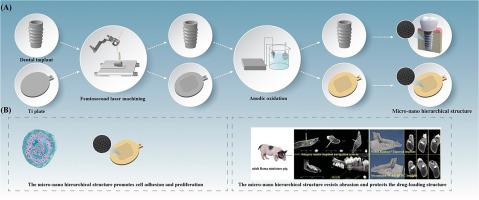Fundamental study on the construction of anti-wear drug delivery system through the design of titanium surface morphology
IF 11.2
1区 材料科学
Q1 MATERIALS SCIENCE, MULTIDISCIPLINARY
引用次数: 0
Abstract
The durability of dental implant carrier coatings is of paramount importance for the expeditious and predictable osseointegration process. The present work is based on a bionic micro/nano hierarchy structure, which consists of titanium surface microstructures and their internal TiO2 nanotubes (TNTs) with drug-carrying capacity. This effectively increases the wear resistance of the drug-carrying coating on the titanium surface. In comparison to untextured samples, the wear volume and wear depth of the optimal texture group are markedly diminished, resulting in a significant enhancement of wear resistance. This improvement was primarily attributed to the smaller contact area of the microstructure. Concurrently, the microstructure serves to safeguard the TNTs from damage during friction. The hydrophilic biomimetic anti-wear micro/nano hierarchies demonstrated the capacity to promote MC3T3-E1 cell adhesion and proliferation, while also exhibiting no cytotoxic effects. Moreover, the micro/nano hierarchical structure can be directly applied to the surface of commercialized implants. In simulated clinical conditions, the implant was inserted into a fresh Bama porcine mandible, and the structure of the drug-loading coatings remained intact. This structure enhances the abrasion resistance of the drug coating while minimizing alterations to the original treatment process of the implant, which is of great significance in the clinical application of implant-loaded drug delivery.

通过钛表面形态设计构建抗磨损给药系统的基础研究
牙科种植体载体涂层的耐久性对于快速和可预测的骨结合过程至关重要。本研究基于一种仿生微/纳米分层结构,它由钛表面微结构及其内部具有载药能力的二氧化钛纳米管(TNTs)组成。这有效提高了钛表面载药涂层的耐磨性。与无纹理样品相比,最佳纹理组的磨损体积和磨损深度明显减小,从而显著提高了耐磨性。这种改善主要归因于微观结构的接触面积更小。同时,微结构还能保护 TNT 在摩擦过程中不受损害。亲水性仿生抗磨损微/纳米分层结构显示出促进 MC3T3-E1 细胞粘附和增殖的能力,同时也没有表现出细胞毒性效应。此外,这种微/纳米分层结构可直接应用于商业化植入物的表面。在模拟临床条件下,将种植体植入新鲜的巴马猪下颌骨,药物负载涂层的结构保持完好。这种结构既增强了药物涂层的耐磨性,又最大限度地减少了对种植体原始处理过程的改变,对种植体载药的临床应用具有重要意义。
本文章由计算机程序翻译,如有差异,请以英文原文为准。
求助全文
约1分钟内获得全文
求助全文
来源期刊

Journal of Materials Science & Technology
工程技术-材料科学:综合
CiteScore
20.00
自引率
11.00%
发文量
995
审稿时长
13 days
期刊介绍:
Journal of Materials Science & Technology strives to promote global collaboration in the field of materials science and technology. It primarily publishes original research papers, invited review articles, letters, research notes, and summaries of scientific achievements. The journal covers a wide range of materials science and technology topics, including metallic materials, inorganic nonmetallic materials, and composite materials.
 求助内容:
求助内容: 应助结果提醒方式:
应助结果提醒方式:


